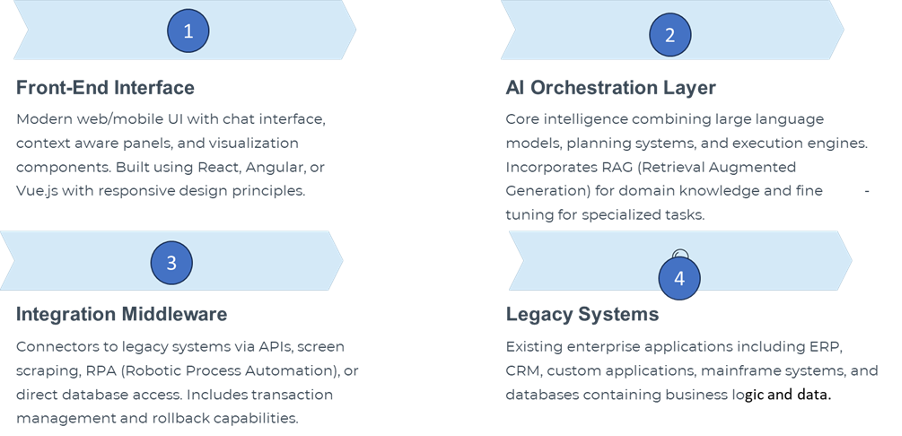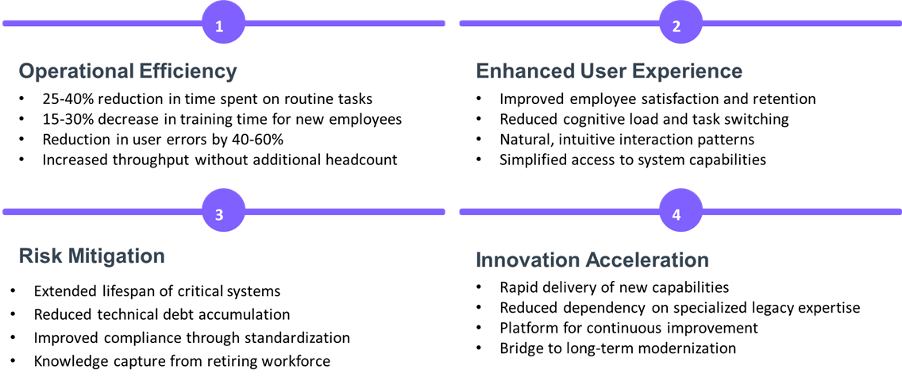
By Rekha Kodali and Vijay Singh
This POV explores how agentic AI can transform legacy enterprise systems without complete rebuilding, specifically through intelligent chat overlays and embedded AI assistants. We examine the technical architecture, implementation strategies, business benefits, and best practices for technology leaders and product managers navigating this transformative approach. By augmenting existing interfaces with intelligent agents, organizations can extend the lifespan of legacy systems while providing modern user experiences and unlocking new capabilities.
The Legacy System Challenge in Enterprise Environments
Enterprise organizations face a significant dilemma with their legacy systems. These established applications often contain decades of business logic, custom configurations, and proprietary data structures that are fundamental to operations. However, they typically present outdated user experiences, limited integration capabilities, and increasing maintenance costs. According to recent industry research, approximately 74% of enterprise IT budgets are dedicated to maintaining existing systems rather than innovation.

The traditional approaches to legacy modernization fall into three categories: replatforming (lifting and shifting to modern infrastructure), refactoring (incrementally improving code quality), or complete replacement. Each approach requires significant investment, specialized expertise, and substantial business risk.
However, a fourth approach has emerged that leverages agentic AI technology to create an intelligent overlay that can bridge legacy functionality with modern interaction paradigms.
This overlay approach allows organizations to preserve their investment in existing systems while incrementally introducing modern capabilities and interfaces. By creating a layer of abstraction between users and the legacy system, organizations can extend system lifespan while planning more strategic long-term modernization efforts.
Understanding Agentic AI: Beyond Simple Assistants
Agentic AI represents a significant evolution beyond traditional chatbots or simple assistive AI. These systems operate with greater autonomy, contextual understanding, and ability to execute complex workflows across multiple systems. Unlike reactive AI systems that respond only to direct queries, agentic AI can proactively identify user needs, navigate complex interfaces, and accomplish multi-step tasks with minimal human guidance.
At its core, agentic AI combines several advanced capabilities:
- Goal-oriented planning and execution
- Memory and contextual understanding across sessions
- Ability to interact with multiple systems through APIs and automation
- Self-improvement through learning from user interactions
- Reasoning about complex business processes and exceptions
When applied to legacy systems, these capabilities allow the AI to serve as both interpreter and executor, translating natural language requests into the complex sequences of actions required by the underlying legacy interface.
Technical Architecture: Building the Intelligent Overlay
Creating an effective AI overlay for legacy systems requires a well-designed architecture that bridges modern AI capabilities with existing enterprise applications. The architecture must address several challenges, including system integration, security, performance, and maintaining data consistency across the AI layer and underlying systems.

Given below are the technical layers for realizing the architecture:
Implementation Considerations
Following need to be taken care of:
- Authentication & Authorization: Single sign-on (SSO) integration ensures the AI agent operates with appropriate user permissions, maintaining security and audit trails.
- System Mapping: Comprehensive mapping of legacy system functions, data structures, and business processes to enable AI navigation and task execution.
- Connection Methods: Multiple integration approaches depending on legacy system capabilities
- API integration for systems with existing interfaces
- RPA for systems without accessible APIs
- Direct database connections with appropriate safeguards
- Custom Middleware for complex integrations
- Caching & Performance: Intelligent caching mechanisms to reduce load on legacy systems while maintaining data freshness.
- Monitoring & Feedback: Comprehensive logging and monitoring to track AI actions, performance impacts, and success rates.
Business Benefits and ROI Considerations

Governance, Ethics, and Risk Management
Implementing agentic AI over legacy systems introduces new governance requirements and risk considerations that organizations must proactively address. A comprehensive governance framework ensures that AI implementations remain secure, compliant, and aligned with organizational values while mitigating potential risks. The technical implementation of agentic AI overlays is only half the battle 3 successful adoption requires thoughtful change management and user enablement. Organizations that neglect the human element of this transition often find their AI investments underutilized or actively resisted, regardless of technical quality.
Conclusion
As Agentic AI technology rapidly evolves, organizations implementing overlays for legacy systems should maintain a forward-looking perspective. The intelligent overlay approach represents not just a tactical solution to immediate legacy challenges, but a strategic platform that can evolve toward increasingly sophisticated capabilities.
Rekha is a Vice President and AI Service Line Head in SLK Software Pvt Ltd. Recognized for her deep expertise in enterprise architecture and IP-led delivery models, Rekha holds certifications in Microsoft Technologies, TOGAF 9, and IASA. Rekha brings with her an impressive experience of leading large-scale digital transformation programs and securing multi-million-dollar strategic wins.
Vijay is a Lead Software Engineer at SLK Software Pvt Ltd, with 10+ years in AI and software development. Skilled in Computer Vision, Generative AI, and Cloud, he builds scalable and impactful solutions. Focused on AI architecture and performance optimization, turning ideas into real-world products. Driven by innovation, he helps businesses leverage AI for growth and transformation.
